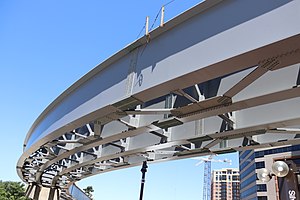The Purple Line is a 16.2-mile (26.1 km) light rail line[3] being built to link several Maryland suburbs of Washington, D.C.: Bethesda, Silver Spring, College Park, and New Carrollton.[7] Currently slated to open in late 2027, the line will also enable riders to move between the Maryland branches of the Red, Green, and Orange lines of the Washington Metro without riding into central Washington, and between all three lines of the MARC commuter rail system. The project is administered by the Maryland Transit Administration (MTA), an agency of the Maryland Department of Transportation (MDOT), and not the Washington Metropolitan Area Transit Authority (WMATA), which operates Metro.
Throughout its decades-long planning process, the project was dogged by resistance, particularly from residents of the upscale community of Chevy Chase and members of the Columbia Country Club. From 2003 to 2006, Maryland Governor Robert Ehrlich changed the proposed mode of transportation from light rail to bus rapid transit. Legal attempts to thwart the line continued even after construction had begun;[8] but in December 2017, the U.S. Court of Appeals for the D.C. Circuit ruled that Purple Line construction could continue despite these objections.[9][10]
In 2016, a consortium headed by Fluor Enterprises won the $5.6 billion contract to design and build the Purple Line, then to operate and maintain it for 36 years.[11][3] Construction began in August 2017.[12] Work halted in September 2020, when the consortium withdrew from the contract, citing mounting delays and disputes with the state government.[13] The project had already consumed $1.1 billion of the anticipated $2 billion construction cost.[14]
A new general contractor was selected in November 2021,[15] and a new contract was signed in April 2022. This new agreement added $3.7 billion to the total cost of building, running, and maintaining the Purple Line for 30 years, bringing it to $9.3 billion. Construction costs alone rose $1.46 billion, bringing the total to $3.4 billion.[16] Full-scale construction activity resumed in summer 2022.[17]
Costs rose and the opening date receded again in 2023[18] and 2024.[19] As of March 2024, the estimated cost to build the line and operate it through 2057 was $9.53 billion, some $4 billion over the initial 2016 budget of $5.6 billion. Train service is expected to begin in December 2027.[19][20]
- ^ a b "Governor O'Malley Announces Purple Line Locally Preferred Alternative" (Press release). New Carrollton, MD: Maryland Department of Transportation (MDOT). August 4, 2009. Archived from the original on September 14, 2015. Retrieved October 18, 2014.
- ^ "Community Advisory Team Meeting #10 (Lyttonsville)". Maryland Transit Administration (MTA). February 28, 2023. p. 13. Archived from the original on April 13, 2023. Retrieved April 13, 2023.
- ^ a b c Freed, Benjamin (March 2, 2016). "Purple Line Construction to Start Later This Year". Washingtonian. Archived from the original on January 27, 2022. Retrieved April 25, 2016.
- ^ Request For Proposals Technical Provisions Part 2B, Design Build Requirements (Report). MDOT/Maryland Transit Administration (MTA). pp. 2–203. Archived from the original on February 7, 2021. Retrieved September 27, 2020.
- ^ Shah, Dhaval R. Presale: Purple Line Transit Partners LLC. Toronto, Ontario, Canada: S&P Global Ratings. p. 14. Archived from the original on December 14, 2018. Retrieved December 11, 2018.
- ^ "MARYLAND LRV". CAF. Archived from the original on July 9, 2023. Retrieved July 9, 2023.
- ^ "Project Overview". Purple Line. Baltimore, MD: MTA. Archived from the original on December 22, 2017. Retrieved July 25, 2015.
- ^ Metcalf, Andrew (December 19, 2016). "Transit Agencies Say Metro's Woes Won't Impact Purple Line". Bethesda Magazine. Archived from the original on July 14, 2018. Retrieved January 12, 2017.
- ^ Shaver, Katherine (December 19, 2017). "Federal appeals court ruling allows Purple Line construction to continue". The Washington Post. Archived from the original on January 28, 2021. Retrieved December 26, 2017.
- ^ Cloherty, Megan (December 19, 2017). "US appeals court clears a legal hurdle for Purple Line". WTOP Radio. Chevy Chase, MD. Archived from the original on January 27, 2022. Retrieved December 26, 2017.
- ^ "Purple Line Contract Receives Green Light From Governor Larry Hogan". Rockville, MD: Montgomery Community Media. March 2, 2016. Archived from the original on March 9, 2021. Retrieved March 2, 2016.
- ^ Shaver, Katherine (September 27, 2018). "Purple Line set to open in fall of 2022, despite year-long delay in construction start, Maryland official says". The Washington Post. Archived from the original on October 8, 2018. Retrieved October 7, 2018.
- ^ Shaver, Katherine (October 9, 2020). "Maryland takes over contracts on Purple Line construction after contractor quits". The Washington Post. Archived from the original on March 4, 2021. Retrieved January 13, 2022.
- ^ Shaver, Katherine (January 12, 2022). "Purple Line will open 4½ years late and cost $1.4 billion more to complete, state says". The Washington Post. Archived from the original on February 24, 2022. Retrieved January 13, 2022.
- ^ Shaver, Katherine (November 5, 2021). "New Purple Line contractors selected to resume full construction this spring". The Washington Post. Archived from the original on November 5, 2021. Retrieved November 8, 2021.
- ^ "New construction contract for Maryland's Purple Line signed". The Washington Post. April 14, 2022. Archived from the original on July 5, 2022. Retrieved April 21, 2022.
- ^ Shaver, Katherine (September 30, 2022). "As Purple Line construction resumes, the fight against gentrification is on". The Washington Post. Archived from the original on December 2, 2022. Retrieved October 18, 2022.
- ^ Cox, Erin (July 14, 2023). "Purple Line further delayed, another $148M over budget". The Washington Post. Retrieved July 14, 2023.
- ^ a b Cite error: The named reference
:3was invoked but never defined (see the help page). - ^ Sears, Bryan P. (March 1, 2024). "Cost of Purple line increases yet again, completion pushed back". Maryland Matters. Retrieved June 5, 2024.


